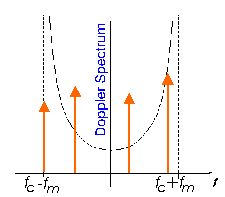
 |
JPL's Wireless Communication Reference WebsiteChapter: Wireless Channels
|

Figure: Approximation (orange) of Theoretical Doppler Spectrum (Black)
We took
Java Applet: Phasor diagram of 9 scattered waves (in blue),
resulting an approximately Rayleigh-fading envelope (in black).
Click on "Settings" to change the Doppler spread (by carrier frequency
and antenna speed)
or to see the amplitude evolve as a function of time.